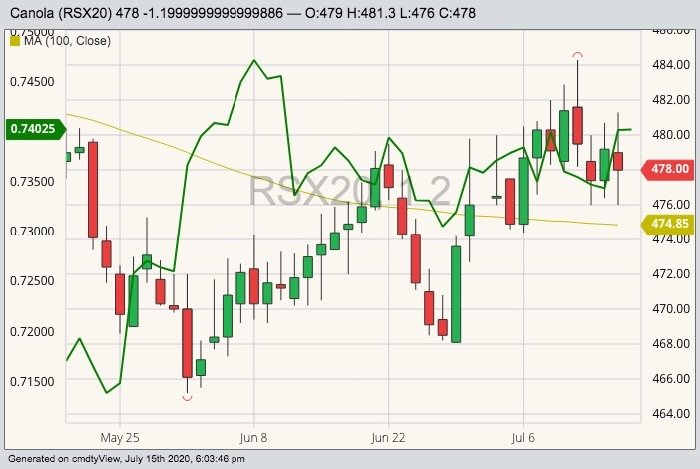MarketsFarm — As the Canadian dollar pushes higher, canola prices could drop to the low end of its support or further, according to Errol Anderson of ProMarket Communications in Calgary.
The loonie closed Wednesday at 73.89 U.S. cents, after stepping above 74 U.S. cents a number of times during trading. At the end of the day, the Canadian dollar gained more than four-10ths of a cent.
In turn, that saw canola prices drop C$1.20 to finish at $478 per tonne for the November contract.
Read Also

Alberta crop conditions improve: report
Varied precipitation and warm temperatures were generally beneficial for crop development across Alberta during the week ended July 8, according to the latest provincial crop report released July 11.
Should the loonie remain on the upswing, Anderson believes canola could fall to $468 per tonne by the fall before it meets resistance to drop any further.
“Especially if the loonie moves above 75 U.S. cents,” he warned.
Part of the conundrum was current weakness in the U.S. dollar index, which managed to finish at 96.00 on Wednesday after trading below that level for much of the day.
Essentially, the greenback lost ground to many of the major currencies around the world, including the loonie, primarily due to the ongoing spat between the U.S. and China and fears the COVID-19 pandemic could ravage the former’s economy.
“By osmosis we’re getting a boost,” Anderson said.
Added to that was the unlikeliness of strong gains in the soy complex on the Chicago Board of Trade. Anderson said it’s extremely likely China will fail to meet its obligations under the Phase One trade agreement with the U.S.
In that agreement’s first year, China was to purchase US$40 billion in U.S. agricultural goods and US$50 billion in the following year. Both would have shattered the record for purchases by China, which is about US$27 billion in the year before its trade war with the U.S. began.
Anderson noted China’s purchases of corn and soybeans during the week of July 13 helped a little, but such was a far cry from being enough.
The U.S. Department of Agriculture reported China acquired about 518,000 tonnes of soybeans and 1.89 million tonnes of corn so far during the week. With the marketing year set to end Sept. 1, and the prospect of large carryovers for the two crops, there will be a lot of pressure on them.
Given canola prices are closely aligned with the Chicago soy complex, should soybeans fall, canola would follow.
— Glen Hallick reports for MarketsFarm from Winnipeg.














